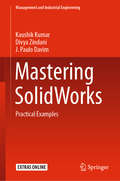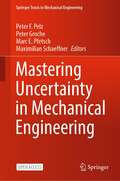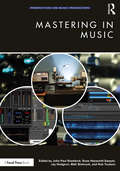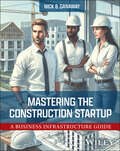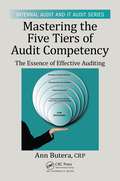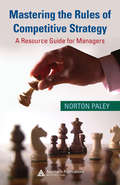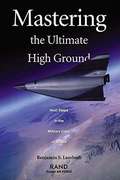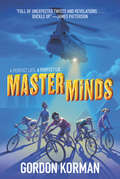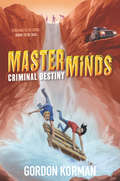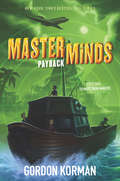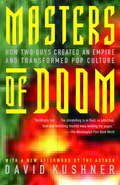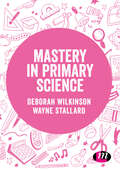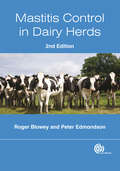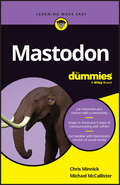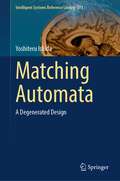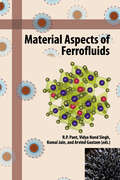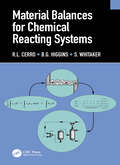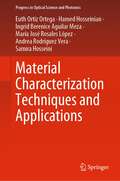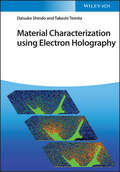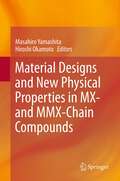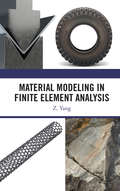- Table View
- List View
Mastering SolidWorks: Practical Examples (Management and Industrial Engineering)
by J. Paulo Davim Kaushik Kumar Divya ZindaniThis book provides the reader with a comprehensive knowledge of all the tools provided in the software SOLIDWORKS for a variety of engineering areas. It presents a broad choice of examples to be imitated in one’s own work. In developing these examples, the authors’ intent has been to exercise many program features and refinements. By displaying these, the authors hope to give readers the confidence to employ these program enhancements in their own modeling applications.
Mastering Uncertainty in Mechanical Engineering (Springer Tracts in Mechanical Engineering)
by Peter Groche Peter F. Pelz Marc E. Pfetsch Maximilian SchaeffnerThis open access book reports on innovative methods, technologies and strategies for mastering uncertainty in technical systems. Despite the fact that current research on uncertainty is mainly focusing on uncertainty quantification and analysis, this book gives emphasis to innovative ways to master uncertainty in engineering design, production and product usage alike. It gathers authoritative contributions by more than 30 scientists reporting on years of research in the areas of engineering, applied mathematics and law, thus offering a timely, comprehensive and multidisciplinary account of theories and methods for quantifying data, model and structural uncertainty, and of fundamental strategies for mastering uncertainty. It covers key concepts such as robustness, flexibility and resilience in detail. All the described methods, technologies and strategies have been validated with the help of three technical systems, i.e. the Modular Active Spring-Damper System, the Active Air Spring and the 3D Servo Press, which have been in turn developed and tested during more than ten years of cooperative research. Overall, this book offers a timely, practice-oriented reference guide to graduate students, researchers and professionals dealing with uncertainty in the broad field of mechanical engineering.
Mastering Your PhD: Survival and Success in the Doctoral Years and Beyond
by Patricia Gosling Bart NoordamThis bestselling book guides PhD students through their graduate years and beyond. Filled with practical advice on getting started, communicating with your supervisor, staying the course, and planning for the future, this book is an indispensable guide for graduate students who need that extra bit of help getting started and making it through. Who should read this book? Any student currently in, or curious about, a PhD programme, be it in the physical and life sciences, engineering, computer science, math, medicine, or the humanities — this book tackles the obstacles and hurdles that almost all PhD students face during their doctoral training. Whether you’re at the very beginning of your research, close to the end, or just feeling frustrated and stuck at any point in between…it’s never too early — or too late — to focus on your success! This third edition contains a variety of new material, including additional chapters and advice on how to make the most of remote learning, collaboration, and communication tools, as well as updated material on your next career step once you have your coveted doctoral degree in hand. Some of the material in the third edition appeared as part of a monthly column on the ScienceCareers website.
Mastering in Music (Perspectives on Music Production)
by Jay Hodgson Russ Hepworth-Sawyer Rob Toulson John Paul Braddock Matt ShelvockMastering in Music is a cutting-edge edited collection that offers twenty perspectives on the contexts and process of mastering. This book collects the perspectives of both academics and professionals to discuss recent developments in the field, such as mastering for VR and high resolution mastering, alongside crucial perspectives on fundamental skills, such as the business of mastering, equipment design and audio processing. Including a range of detailed case studies and interviews, Mastering in Music offers a comprehensive overview of the foremost hot topics affecting the industry, making it key reading for students and professionals engaged in music production.
Mastering the Construction Startup: A Business Infrastructure Guide
by Nick B. GanawayEQUIPS STARTUP CONTRACTORS WITH THE TOOLS TO BUILD RESILIENT INFRASTRUCTURE IN THE CONSTRUCTION INDUSTRY For construction professionals starting their businesses, success depends on more than just skill and dedication. Mastering the Construction Startup provides an essential master plan for creating the foundational infrastructure every contractor needs to achieve sustainable growth and upon which every strategic decision will be made. Written by industry expert Nick B. Ganaway, this real-world guide details how to strategically align people, systems, and processes with business goals to proactively address risks, reduce errors, and build lasting operational resilience. Grounded in decades of general contracting experience and research, each concise and accessible chapter breaks down the key components of sustainable success, such as identifying elements of a solid legal and financial base, establishing relationships with essential professionals, and creating a culture that attracts and retains the best talent. Throughout the book, Ganaway, often engaging directly with the reader, offers expert insights on everything from the role of the contractor to elements of leadership to advantages of niche contracting. Mastering the Construction Startup empowers contractors to set up their companies for success during the challenging early years and beyond. Here is a small sample of the principles discussed: Why your company’s culture is critical to your success and how to ensure it will be what you wantBilling procedures to follow to ensure that you get paid for your workYour essential need to hire the right lawyer and the right accountant for your business before your Day 1Your personal guarantee, its extreme risk for you, and what to do when it is requiredThe legal and financial consequences of improper business registration and professional licensingHow to choose the form of business structure best suited to your companyAn essential checklist for startups, and forms you can use The risks inherent in the Sole Proprietorship form of businessThe problems with partnerships and how to address them in advance Mastering the Construction Startup: A Business Infrastructure Guide is perfect for trade school and college courses in construction management and entrepreneurship, and a must-have resource for contractors, project managers, and subcontractors at all levels.
Mastering the Five Tiers of Audit Competency: The Essence of Effective Auditing (ISSN)
by Ann ButeraRisk-based operational audits and performance audits require a broad array of competencies. This book provides auditors and risk professionals with the understanding required to improve results during risk-based audits.Mastering the Five Tiers of Audit Competency: The Essence of Effective Auditing is an anthology of powerful risk-based auditing pra
Mastering the Rules of Competitive Strategy: A Resource Guide for Managers
by Norton PaleyThe stakes are high and real. Money is spent. Personnel are committed in a battle for the triumph or downfall of a company. Yet, given the same circumstances, some companies continue to thrive while others wash out and become also-rans. In the end, it is the dynamics of the competitive marketplace, the quality of the organization‘s business plan, a
Mastering the Ultimate High Ground: Next Steps in the Military Uses of Space
by Benjamin S. LambethAssesses the military space challenges facing the Air Force and the nation in light of the findings and recommendations of the Space Commission. The author reviews the Air Force?'s involvement in space since its creation as an independent service in 1947; examines the circumstances that occasioned the commission?'s creation and the conceptual and organizational roadblocks that have impeded a more rapid growth of U.S. military space capability; and enumerates the challenges facing the Air Force with respect to space.
Masterminds (Masterminds #1)
by Gordon Korman<P>Action-packed and full of unexpected twists, this new series from New York Times bestselling author Gordon Korman is perfect for young fans of James Patterson and John Grisham. <P>Eli Frieden lives in the most perfect town in the world: Serenity, New Mexico. In this idyllic place, every lawn is perfectly manicured and everyone has a pool and a tree house. Honesty and integrity are valued above all else. The thirty kids who live there never lie--they know it's a short leap from that to the awful problems of other, less fortunate places. <P>Eli has never left Serenity . . . Why would he ever want to? Then one day he bikes to the edge of the city limits and something so crazy and unexpected happens, it changes everything. Eli convinces his friends to help him investigate further, and soon it becomes clear that nothing is as it seems in Serenity. The clues mount to reveal a shocking discovery, connecting their ideal crime-free community to some of the greatest criminal masterminds ever known. The kids realize they can trust no one--least of all their own parents. <P><b> Nominee for the 2018 Young Reader's Choice Award </b> <i>(Pacific Northwest Library Association)</i>
Masterminds: Criminal Destiny (Masterminds #2)
by Gordon Korman<P>The second book in the acclaimed, action-packed series from New York Times bestselling author Gordon Korman. <P>The clones of Project Osiris are free--but they're being hunted. . . . After their narrow escape from their "perfect" hometown, Eli, Tori, Amber, and Malik are finally in the real world and determined to expose the leaders of Serenity. They decide to track down Tamara Dunleavy, the mysterious billionaire and founder of Project Osiris. Evading capture by breaking laws and sneaking into houses, hotels, buses, and cars--are they becoming the criminals they were destined to be? <P>What they discover will change everything, leading them straight into the Plastic Works and the heart of the experiment, in order to uncover the deadly criminals they're cloned from--and any evidence that will convince the outside world to believe the truth. But the outside world isn't exactly what they expected--strangers aren't just unfriendly, they're dangerous. And the wrong move could send them right back into the arms of Dr. Hammerstrom--and trapped in Serenity for good.On a breakneck journey from Jackson Hole to a maximum security prison--Eli, Tori, Amber, and Malik will stop at nothing to take Project Osiris down. <P><b> Nominee for the 2018 Young Reader's Choice Award </b> <i>(Pacific Northwest Library Association)</i>
Masterminds: Payback (Masterminds #3)
by Gordon Korman<P>The thrilling finale to the New York Times-bestselling Masterminds series from middle grade star author Gordon Korman. Perfect for fans of Rick Riordan and James Patterson. <P>After a serious betrayal from one of their former friends, the clones of Project Osiris are on the run again. Now separated into pairs, Eli and Tori and Amber and Malik are fighting to survive in the real world.Amber and Malik track down the one person they think can help them prove the existence of Project Osiris, notorious mob boss Gus Alabaster, also known as Malik’s DNA donor. But as Malik gets pulled into the criminal world—tantalized by hints of a real family—his actions put him and Amber into greater danger. <P>Eli and Tori get sucked into even bigger conspiracies as they hunt down Project Osiris’s most closely guarded secrets—who does Eli’s DNA come from? With a surprising new ally and another cross-country adventure, the four will have to work together to overcome the worst parts of themselves if they are going to end Project Osiris once and for all. <P><b> Nominee for the 2018 Young Reader's Choice Award </b> <i>(Pacific Northwest Library Association)</i>
Masters of Doom: How Two Guys Created an Empire and Transformed Pop Culture
by David Kushner"To my taste, the greatest American myth of cosmogenesis features the maladjusted, antisocial, genius teenage boy who, in the insular laboratory of his own bedroom, invents the universe from scratch. Masters of Doom is a particularly inspired rendition. Dave Kushner chronicles the saga of video game virtuosi Carmack and Romero with terrific brio. This is a page-turning, mythopoeic cyber-soap opera about two glamorous geek geniuses--and it should be read while scarfing down pepperoni pizza and swilling Diet Coke, with Queens of the Stone Age cranked up all the way." --Mark Leyner, author of I Smell Esther Williams. Masters of Doom is the amazing true story of the Lennon and McCartney of video games: John Carmack and John Romero. Together, they ruled big business. They transformed popular culture. And they provoked a national controversy. More than anything, they lived a unique and rollicking American Dream, escaping the broken homes of their youth to co-create the most notoriously successful game franchises in history--Doom and Quake--until the games they made tore them apart. Americans spend more money on video games than on movie tickets. Masters of Doom is the first book to chronicle this industry's greatest story, written by one of the medium's leading observers. David Kushner takes readers inside the rags-to-riches adventure of two rebellious entrepreneurs who came of age to shape a generation. The vivid portrait reveals why their games are so violent and why their immersion in their brilliantly designed fantasy worlds offered them solace. And it shows how they channeled their fury and imagination into products that are a formative influence on our culture, from MTV to the Internet to Columbine. This is a story of friendship and betrayal, commerce and artistry--a powerful and compassionate account of what it's like to be young, driven, and wildly creative.
Mastery in primary science (Exploring the Primary Curriculum)
by Deborah Wilkinson Wayne StallardWhat does 'mastery' look like in primary science? How can teachers plan for, assess and evidence it? This book explores how ‘rich’ learning tasks that enable children to apply, analyse, evaluate, and/or create to solve exciting and novel problems support the development of mastery level knowledge and skills in primary science. - Outlines how to recognise and use assessment opportunities - Focuses on the development of conceptual understanding - Highlights and demontrates the importance of teacher questioning - Explores the theories behind 'mastery' for primary science
Mastery in primary science (Exploring the Primary Curriculum)
by Deborah Wilkinson Wayne StallardWhat does 'mastery' look like in primary science? How can teachers plan for, assess and evidence it? This book explores how ‘rich’ learning tasks that enable children to apply, analyse, evaluate, and/or create to solve exciting and novel problems support the development of mastery level knowledge and skills in primary science. - Outlines how to recognise and use assessment opportunities - Focuses on the development of conceptual understanding - Highlights and demontrates the importance of teacher questioning - Explores the theories behind 'mastery' for primary science
Mastitis Control in Dairy Herds
by Peter Edmondson Roger BloweyMastitis in dairy herds is a worldwide problem, with significant implications for milk yields and quality, economic losses, and animal health and welfare. Effective control makes a considerable difference to the farmer and the animal, and this new edition includes updated information throughout as well as new chapters covering organic dairy herds, dry period infections, robotic milking, residue avoidance, and best practice procedures. The authors, both fellows of the Royal College of Veterinary Surgeons and recognised experts in the field, provide basic principles relevant to farmers, vets and veterinary students in a clear and practical way, covering anatomy, epidemiology, milking machines, disinfection, somatic cell counts, and diseases of the udders and teats in order to provide a thorough understanding of the causes of mastitis and measures of control and prevention. It is an indispensable resource for large animal vets, dairy industry personnel, farm managers, dairy herdsmen, and researchers and students in animal sciences and related disciplines.
Mastodon For Dummies
by Chris Minnick Michael McCallisterA little birdy told us you needed to know more about Mastodon Ready to escape the drama of existing social media platforms and try something new and awesome in the world of social media? In Mastodon For Dummies, experienced tech trainers Chris Minnick and Mike McCallister show you exactly how to use Mastodon, the hot decentralized social media offering on the web and destination for thousands of social media migrants. Learn how to sign up for the service on your choice of server and get familiar with the rules of what’s sure to become your new favorite app. You’ll discover how to connect with other people, attract your own followers, and make yourself right at home in the Mastodon community. In the book, you’ll find: Easy-to-follow instructions on how to choose the Mastodon server that suits you best Instructions for establishing new connections on a new social platform and learning the rules of the road Tips for conducting business on Mastodon and making a home for your home-based business or brand on the social media service Step-by-step guides on launching your very own serverIf you’re ready to leave old social platforms in the rear-view and try something new, grab a copy of Mastodon For Dummies.
Matching Automata: A Degenerated Design (Intelligent Systems Reference Library #271)
by Yoshiteru IshidaWhat does the future of AI hold—a supportive partner or a rival with its own illusion of self? This book explores this critical question by introducing degenerated design, a groundbreaking framework for creating resilient, adaptive systems inspired by natural processes like immunity and collective intelligence. Rejecting traditional optimization-focused AI paradigms, this approach embraces imperfection and diversity as essential for building intelligent systems that thrive in dynamic environments. Spanning industries such as robotics, automotive, biotechnology, quantum computing, and space exploration, the book also ventures into the cognitive dimensions of AI. Inspired by human sensory systems, it proposes a two-sided model, possibly extendable to that of consciousness, exploring the interplay between passive automata and active intentional agents. It delves into the origins and illusions of self-consciousness, examining its survival merits and dangers in both biological and artificial contexts. A must-read for system designers, CEOs, and AI researchers, this book also challenges academics and students to rethink the future of generative AI and antiAI systems. This book is both a technical blueprint and a philosophical exploration of AI’s potential to liberate or confront humanity. The future of human AI coexistence starts here.
Matching Markets for Googlers
by Rembrand Koning Bo CowgillProfessor Bo Cowgill (Columbia Business School) and HBS Professor Rembrand Koning prepared this case. Professors Cowgill and Koning contributed equally to the development of this case and are listed in alphabetical order. It was reviewed and approved before publication by a company designate. Funding for the development of this case was provided by Harvard Business School and not by the company. Bo Cowgill previously worked at Google and provided advice on market design while employed there. Certain details have been disguised. HBS cases are developed solely as the basis for class discussion. Cases are not intended to serve as endorsements, sources of primary data, or illustrations of effective or ineffective management.
Material Aspects of Ferrofluids
by Vidya Nand Singh R. P. Pant Komal Jain Arvind GautamFerrofluids are smart materials possessing high controllability over its sensing and actuations behaviour which makes them suitable for contemporary technology. This book provides a comprehensive and accessible account of the material aspects of ferrofluids and its composites. It covers all the aspects of ferrofluids from physical to colloid stability factors, optical to thermal behaviour and rheological properties. An account of ferrofluid applications such as fine polishing, energy conversion, biomedical and further scope is presented. This book is indispensable for researchers, academicians and technologists working on magnetic nanosuspensions.
Material Balances for Chemical Reacting Systems
by S. Whitaker R.L. Cerro B.G. HigginsWritten for use in the first course of a typical chemical engineering program, Material Balances for Chemical Reacting Systems introduces and teaches students a rigorous approach to solving the types of macroscopic balance problems they will encounter as chemical engineers. This first course is generally taken after students have completed their studies of calculus and vector analysis, and these subjects are employed throughout this text. Since courses on ordinary differential equations and linear algebra are often taken simultaneously with the first chemical engineering course, these subjects are introduced as needed. Teaches readers the fundamental concepts associated with macroscopic balance analysis of multicomponent, reacting systems Offers a novel and scientifically correct approach to handling chemical reactions Includes an introductory approach to chemical kinetics Features many worked out problems, beginning with those that can be solved by hand and ending with those that benefit from the use of computer software This textbook is aimed at undergraduate chemical engineering students but can be used as a reference for graduate students and professional chemical engineers as well as readers from environmental engineering and bioengineering. The text features a solutions manual with detailed solutions for all problems, as well as PowerPoint lecture slides available to adopting professors.
Material Characterization Techniques and Applications (Progress in Optical Science and Photonics #19)
by Samira Hosseini Euth Ortiz Ortega Hamed Hosseinian Ingrid Berenice Aguilar Meza María José Rosales López Andrea Rodríguez VeraThis book presents commonly applied characterization techniques in material science, their brief history and origins, mechanism of operation, advantages and disadvantages, their biosensing applications, and troubleshooting for each technique, while addressing the challenges researchers face when working with these techniques. The book dedicates its focus to identifying physicochemical and electrochemical nature of materials including analyses of morphology, mass spectrometry, and topography, as well as the characterization of elemental, structural, thermal, wettability, electrochemical, and chromatography properties. Additionally, the main features and benefits of using coupled characterization techniques are discussed in this book.
Material Characterization Using Electron Holography
by Daisuke Shindo Takeshi TomitaMaterial Characterization using Electron Holography Exploration of a unique technique that offers exciting possibilities to analyze electromagnetic behavior of materials Material Characterization using Electron Holography addresses how the electromagnetic field can be directly visualized and precisely interpreted based on Maxwell’s equations formulated by special relativity, leading to the understanding of electromagnetic properties of advanced materials and devices. In doing so, it delivers a unique route to imaging materials in higher resolution. The focus of the book is on in situ observation of electromagnetic fields of diverse functional materials. Furthermore, an extension of electron holographic techniques, such as direct observation of accumulation and collective motions of electrons around the charged insulators, is also explained. This approach enables the reader to develop a deeper understanding of functionalities of advanced materials. Written by two highly qualified authors with extensive first-hand experience in the field, Material Characterization using Electron Holography covers topics such as: Importance of electromagnetic fields and their visualization, Maxwell’s equations formulated by special relativity, and de Broglie waves and wave functions Outlines of general relativity and Einstein’s equations, principles of electron holography, and related techniques Simulation of holograms and visualized electromagnetic fields, electric field analysis, and in situ observation of electric fields Interaction between electrons and charged specimen surfaces and interpretation of visualization of collective motions of electrons For materials scientists, analytical chemists, structural chemists, analytical research institutes, applied physicists, physicists, semiconductor physicists, and libraries looking to be on the cutting edge of methods to analyze electromagnetic behavior of materials, Material Characterization using Electron Holography offers comprehensive coverage of the subject from authoritative and forward-thinking topical experts.
Material Designs and New Physical Properties in MX- and MMX-Chain Compounds
by Masahiro Yamashita Hiroshi OkamotoThis is the first book to comprehensively address the recent developments in both the experimental and theoretical aspects of quasi-one-dimensional halogen-bridged mono- (MX) and binuclear metal (MMX) chain complexes of Pt, Pd and Ni. These complexes have one-dimensional electronic structures, which cause the various physical properties as well as electronic structures. In most MX-chain complexes, the Pt and Pd units are in M(II)-M(IV) mixed valence or charge density wave (CDW) states due to electron-phonon interactions, and Ni compounds are in Ni(III) averaged valence or Mott-Hubbard states due to the on-site Coulomb repulsion. More recently, Pd(III) Mott-Hubbard (MH) states have been realized in the ground state by using the chemical pressure. Pt and Pd chain complexes undergo photo-induced phase transitions from CDW to MH or metal states, and Ni chain complexes undergo photo-induced phase transitions from MH to metal states. Ni chain complexes with strong electron correlations show tremendous third-order optical nonlinearity and nonlinear electrical conductivities. They can be explained theoretically by using the extended Peierls-Hubbard model. For MMX-chain complexes, averaged valence, CDW, charge polarization, and alternating charge polarization states have been realized by using chemical modification and external stimuli, such as temperature, photo-irradiation, pressure, and water vapor. All of the electronic structures and phase transitions can be explained theoretically.
Material Inhomogeneities in Elasticity
by G.A. MauginSelf contained, this book presents a thorough introduction to the complementary notions of physical forces and material (or configurational) forces. All the required elements of continuum mechanics, deformation theory and differential geometry are also covered. This book will be a great help to many, whilst revealing to others a rather new facet of continuum mechanics in general, and elasticity in particular. An organized exposition of continuum mechanics on the material manifold is given which allows for the consideration of material inhomogeneities in their most appropriate framework. In such a frame the nonlinear elasticity of anisotropic inhomogenous materials appears to be a true field theory. Extensions to the cases of electroelasticity and magnetelasticity are then straightforward. In addition, this original approach provides systematic computational means for the evaluation of characteristic parameters which are useful in various branches of applied mechanics and mathematical physics. This is the case for path-independent integrals and energy-release rates in brittle fracture, the influence of electromagnetic fields on fracture criteria (such as in ceramics), the notion of momentum of electromagnetic fields in matter in optics, and the perturbation of solitons propagating in elastic dispersive systems.
Material Modeling in Finite Element Analysis
by Z. YangFinite element analysis has been widely applied in mechanical, civil, and biomedical designs. This book aims to provide the readers comprehensive views of various material models with practical examples, which would help readers understand various materials, and build appropriate material models in the finite element analysis. This book is composed of four main parts: 1) metals, 2) polymers, 3) soils, and 4) modern materials. Each part starts with the structure and function of different materials and then follows the corresponding material models such as BISO, MISO, Chaboche model in metals, Arruda-Boyce model, Mooney-Rivlin model, Ogden model in polymers, Mohr-Coulomb model, Cam Clay model and Jointed Rock model in geomechanics, composites and shape memory alloys in modern materials. The final section presents some specific problems, such as metal forming process, combustion chamber, Mullins effect of rubber tire, breast shape after breast surgery, viscoelasticity of liver soft tissues, tunnel excavation, slope stability, orthodontic wire, and piezoelectric microaccelerometer. All modeling files are provided in the appendixes of the book. This book would be helpful for graduate students and researchers in the mechanical, civil, and biomedical fields who conduct finite element analysis. The book provides all readers with comprehensive understanding of modeling various materials.
